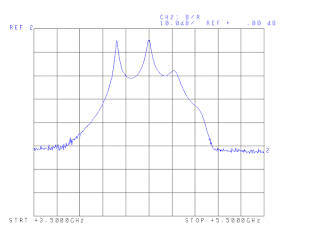Now that my HP 8566B is fixed, I have been able to test the harmonic mixers I made based on the SDMG designs.
I mounted an HSMS-8202 mixer diode on an SMA connector and added a semi-rigid coax feed for the IF (with a tiny wire run through a hole drilled in the SMA connector, and formed into an air-core inductor to act as the diplexer). The LO connects to the SMA connector and RF will be picked up by the SMA center pin (at about 1.5mm height, it's close to a quarter-wave at 47GHz).
I tested at first with the 24GHz Gunn oscillators I have had for a while, but of course I don't need to use an external mixer for these as the 8566B can be convinced to span up to 25GHz in the harmonic locked mode (shift-t). But now I was determined to use the external mixer modes accessed by the shift-U function.
For the next amateur radio band at 47GHz, I had to make a signal source: this is another SMA connector with microwave diode, this time an HSMS286C high frequency schottky. No IF connection needed here, as I'm just multiplying the input frequency. If I wanted to make a transverter, I would have to add an IF input just like the mixer above. I mounted the center pin of the SMA connector in the focal point of a flashlight reflector to act as a parabolic dish antenna. At these frequencies, radio waves act more like light!
To get 47.1GHz out, I had to multiply a lower frequency, and my best bet was the HP8350 sweeper with 83545A plug-in, as this can put out over 22dBm in the 6-12GHz range. I chose to use the 5th harmonic of 9.42GHz, which turns out to be 47.1GHz.
I mounted an HSMS-8202 mixer diode on an SMA connector and added a semi-rigid coax feed for the IF (with a tiny wire run through a hole drilled in the SMA connector, and formed into an air-core inductor to act as the diplexer). The LO connects to the SMA connector and RF will be picked up by the SMA center pin (at about 1.5mm height, it's close to a quarter-wave at 47GHz).
I tested at first with the 24GHz Gunn oscillators I have had for a while, but of course I don't need to use an external mixer for these as the 8566B can be convinced to span up to 25GHz in the harmonic locked mode (shift-t). But now I was determined to use the external mixer modes accessed by the shift-U function.
For the next amateur radio band at 47GHz, I had to make a signal source: this is another SMA connector with microwave diode, this time an HSMS286C high frequency schottky. No IF connection needed here, as I'm just multiplying the input frequency. If I wanted to make a transverter, I would have to add an IF input just like the mixer above. I mounted the center pin of the SMA connector in the focal point of a flashlight reflector to act as a parabolic dish antenna. At these frequencies, radio waves act more like light!
To get 47.1GHz out, I had to multiply a lower frequency, and my best bet was the HP8350 sweeper with 83545A plug-in, as this can put out over 22dBm in the 6-12GHz range. I chose to use the 5th harmonic of 9.42GHz, which turns out to be 47.1GHz.
And what do you know, it works! (For the bottom picture, I placed the diode multiplier next to the mixer input at bottom right in the picture, as it was too hard to hold both the flashlight relector and the camera at the same time.) I only sent the signal about a meter, but at 47GHz, that's 157 wavelengths - the equivalent of 25km for the 160m band....
The signal drifts around a bit, as the 8350/83545 sweeper isn't phase-locked, but at least I can pick it up. Next I might try modifying the HP83545A plug-in to act as an amplifier for my HP 8672A synthesised signal generator. If I had a source-locking microwave frequency counter like the EIP575/578 that wouldn't be necessary, but the gods of eBay have not provided me with such a thing.
-mark.
















